






The Auraria Campus is an urban commuter campus located in Denver, Colorado and is home to the Community College of Denver (CCD), Metropolitan State University of Denver (MSU), and the University of Colorado Denver (CU Denver). In addition to being shared between three higher education institutions, Auraria Campus is owned and managed by the Auraria Higher Education Institution (AHEC).
As a result of the dynamic between the institutions and AHEC calling Auraria Campus home, first-year commuting students struggle to navigate campus, campus buildings, and find campus

resources. Some campus buildings are owned or operated by one institution while others are shared between all three. Throughout the campus, there exists little signage to welcome new students to campus and guide them to their classes, offices, or other resources.
By providing little support in the form of way-finding, new students spend the beginning of their semester learning the layout of campus instead of making friends and building their sense of belonging to Auraria Campus.
How might the application of user experience design principles provide first-year commuter students on the Auraria Campus with consistently positive experiences and a stronger sense of belonging?

• Brainstorm design problem
• Identify design mentors
• Begin preliminary research
SEPTEMBER
• Continue research
• Email mentor candidates
• Draft Problem Statement
• Draft Research Question
NOVEMBER
• Finalize research
• Meet with subject matter experts
• Revise Problem Statement
• Revise Research Question
OCTOBER
• Continue research
• Meet with mentors
• Identify subject matter experts
• Revise Problem Statement
• Revise Research Question
• Design solution brainstorm and sketching
• Refine research question
• Campus walkthrough
• Design Solution Ideation
• Continue Process Book
• RedLine Installation proposal
• Preliminary brainstorm of design solutions
FEBRUARY
• Begin process book
• Create student survey
• Survey students
• Analyze survey results
• Photograph campus spaces and signage
APRIL
• Finish Process Book
• Complete design solutions
• Install at RedLine
Before the start of my first semester of college, I, like many other first-year students, walked through my class schedule to locate all my classes. I made sure to leave early on the first day, so that I would not be late, and subsequently arrived to class chronically early. Since my first semester of college, I have worked with several first-year students who prefer instead “wing-it” their first week of class, and as you can probably imagine, are often late to said classes. But, it’s hard to fault them for this error in judgment when North Classroom’s 5th floor can only be access from one side of the building, Plaza has a mezzanine floor, the only elevator to get to the second floor in West Classroom is actually in the Arts Building, and Tivoli 479 is really on the
second floor instead of the fourth, and it’s outside.
As a first-year student, you are juggling not only making friends, waking up on time, balancing your finances, doing your homework, but now to top it off you have a question for the bursar’s, but you don’t know if you talk to them at Lynx Central or Lynx Connect. Instead of building your sense of belonging to your new college environment, you’re lost, confused, and probably more than a bit frustrated.

In his research on student belonging, Terrell Strayhorn argues that finding belonging is “a fundamental need for all people” like food and shelter.1 This means that before you can focus on other things, like turning in your math
1 Terrell Strayhorn, College Students’ Sense of Belonging: A Key to Educational Success for all Students (New York and London: Routledge, 2019), 9.
homework, you are seeking to fulfill your need to belong.2 If this need is not satisfied, a college student is less likely to graduate from college.3 And so, for my project I decided to evaluate Auraria Campus through the lens of a first-year student to explore the ways in which user experience principles could be used to design way-finding solutions to help reduce the time it takes for first-year students to find belonging on campus.
Roughly a decade ago, in 2012, the Auraria Higher Education Center (AHEC) proposed a long-term master plan to revitalize the urban nature of the campus. Auraria Campus is shared between three higher education institutions: the Community College of Denver (CCD), Metropolitan State University of Denver (MSU), and the University of Colorado Denver (CU Denver). As a result of the plan, the campus land is divided into different “neighborhoods” for each institution in addition to a shared portion of campus.4 The intention of these neighborhoods is to provide space for each institution to complete building projects while also maintaining a collaborative space; individual projects would have to abide
by set guidelines to align with the identity of Auraria Campus.5 In addition to establishing campus neighborhoods, the 2012 plan also focused on ideas to improve the user experience of campus such as updating the different campus “entrances” to visually establish Auraria Campus as being separate from Downtown Denver.6 The plan also detailed architectural changes to campus to allow for more walkable routes, outdoor seating, and bicycle use.7
In the years since the publication of the 2012 plan, few of the proposed construction projects have been completed. As a result, Auraria Campus has not improved the campus user experience for new students. While the campus is not large, AHEC has not provided campus users with way-finding systems to welcome and guide students around campus. Without obvious guidance around campus, a new student will begin to have a negative impression of Auraria Campus’s identity and credibility in addition to remembering their experience on campus as an unpleasant one.8 This negative impression is a result of having a more challenging time locating
2 Strayhorn, College Students’ Sense of Belonging, 9.
3 Strayhorn, College Students’ Sense of Belonging, 16.
4 From Vision to Reality (Denver: Auraria Higher Education Center, 2012), 31-48.
5 From Vision to Reality (Denver: Auraria Higher Education Center, 2012), 31.
6 From Vision to Reality (Denver: Auraria Higher Education Center, 2012), 80-123.
7 From Vision to Reality (Denver: Auraria Higher Education Center, 2012), 35-43.
8 Joowon Ahn, “Way-finding at the East Campus of Cayuga Medical Denver in Ithaca, NY,” 15.
buildings, classrooms, offices, and resources across campus due to a lack of way-finding. Strayhorn describes this as drawing upon one’s “working memory” but “trying to manage too many activities simultaneously can overdraw ‘working memory’ (also known as one’s ‘bandwidth’) and lead to poor output, loss of quality, or failure. Similar wisdom holds for college students craving a sense of belonging.”9 If a first-year student is using up all of their working memory trying to navigate campus, they will have to wait longer to have enough bandwidth to begin to satisfy their need to belong.
By creating a consistent way-finding system across Auraria Campus, a firstyear student will be able to dedicate less energy to finding their way around
campus and instead focus on building their sense of belonging. A way-finding system will also build AHEC’s integrity with first-year students in addition to building Auraria Campus’s identity as an urban campus shared between three institutions. Having positive experiences with the campus enables students to share their positive experiences and encourage others to attend school at one of the higher education institutions.

9 Strayhorn, College Students’ Sense of Belonging, 16.
“In terms of college, sense of belonging refers to students’ perceived social support on campus, a feeling or sensation of connectedness, and the experience of mattering or feeling cared about, accepted, respected, valued by, and important to the campus community or others on campus such as faculty, staff, and peers.”
-Terrell Strayhorn

Between buildings, even buildings within the same neighborhood, the hierarchy, color, and other visual cues on signage is inconsistent, confusing or in the wrong locations. The Lawrence and Larimar bridge signs make one think that they must go down to the river to find certain buildings. Some signs blend in with the color of the walls. The map in North only exists at one entrance.
The “entrances” to campus do not visually communicate the end of Downtown Denver and the start of Auraria Campus. The general Auraria Campus signage is limited and resembles CU Denver’s brand style instead of AHEC’s.

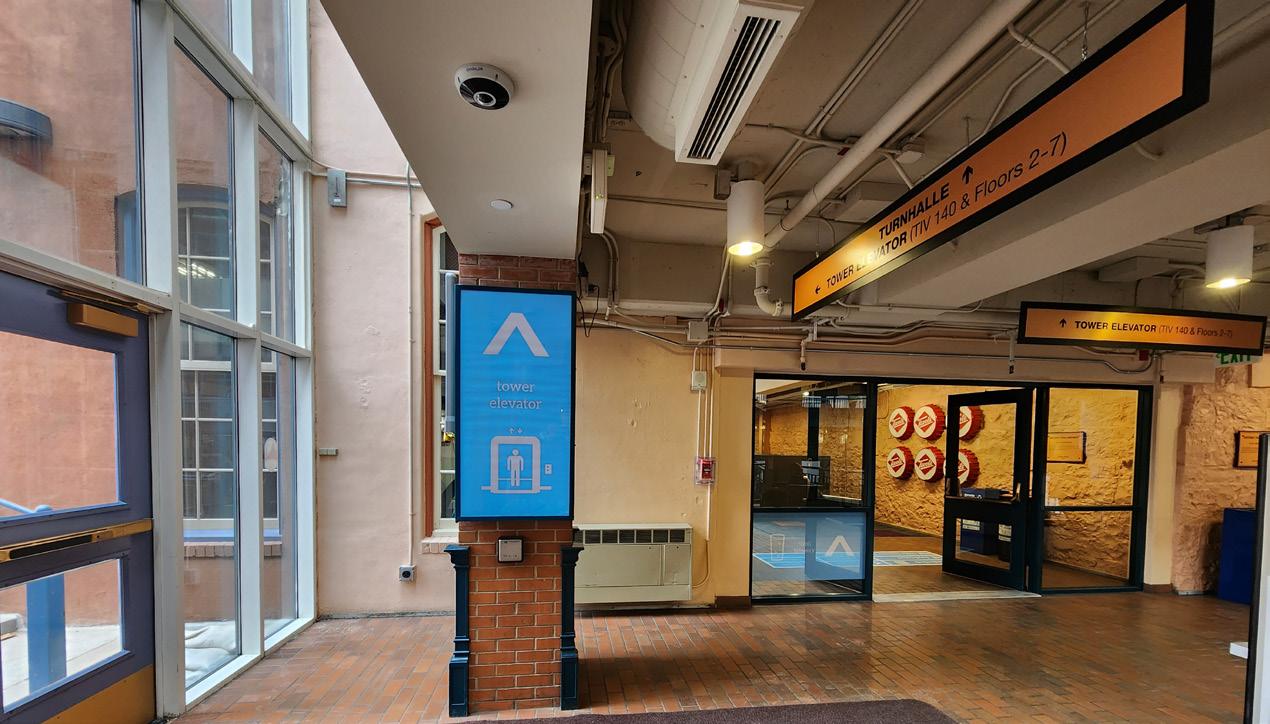





The Tivoli Student Union utilizes three different methods of way-finding. These methods are inconsistent from floor to floor. Often, there are locations with many solutions and other locations with none.

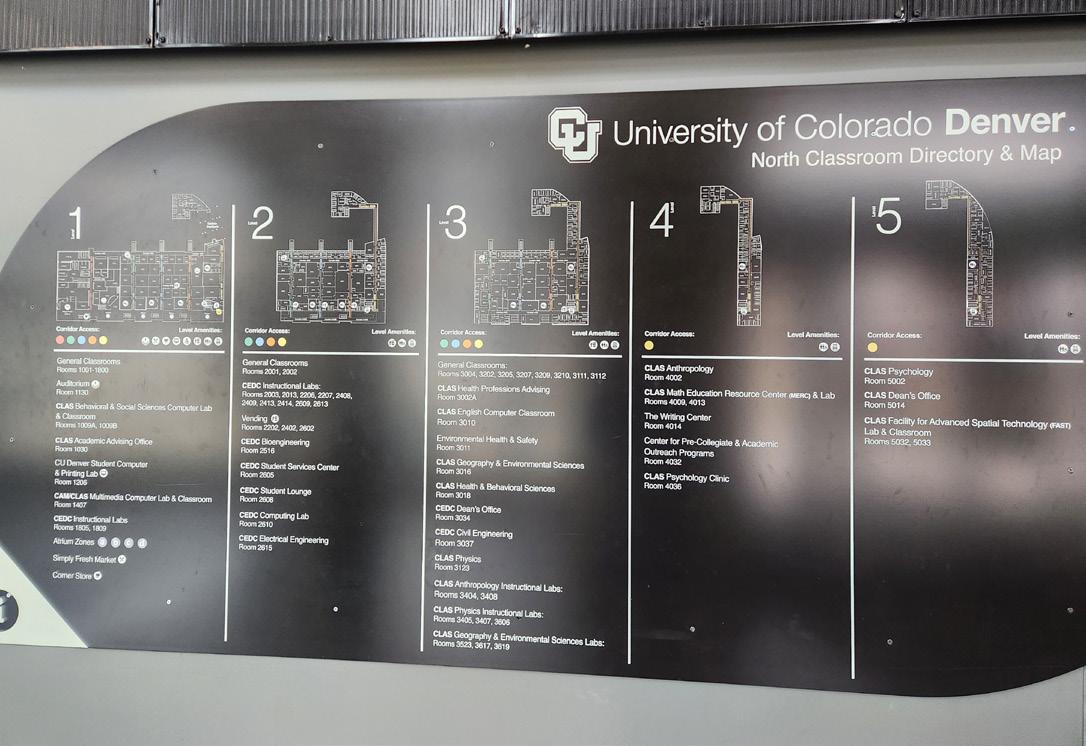




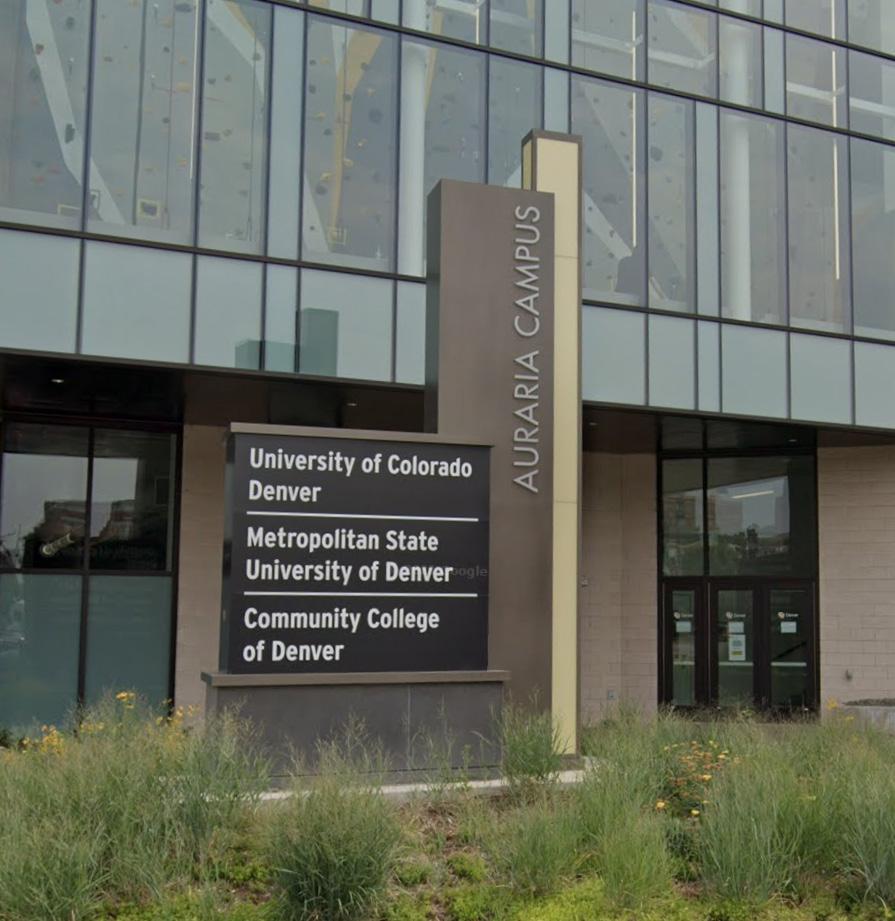


To gain a more holistic perspective of the ways in which student utilize, navigate and interact with Auraria Campus, I conducted a survey of current undergraduate students, graduate students, and staff on the campus.
While I had questions for students attending MSU and CCD, I was only able to survey CU Denver students and staff across areas of study and year in school. Of the 63 responses, 71% do not live on campus or in nearby student housing. 58% of respondents started at CU Denver as first-year students while 41% transfered to the university.
Of the 18 provided campus locations, 54% of respondents reported that they spend a majority of their time in the Tivoli Student Union between classes. The next most frequented locations were Learning Commons (36%), North Classroom (34%), and the Auraria Library (25%). As I only surveyed CU
Denver students, the results of this question are skewed towards buildings located in the CU Denver neighborhood, or the shared neighborhood, of campus. After demographic information, I also asked respondents a series of questions that asked if they knew the location of a campus resource, and then if they were able to navigate to the resource on their own. These questions were asked in the form of a scale from 1 (strongly disagree) to 5 (strongly agree).
Finally, I asked respondents a series of free response questions asking what campus spaces and experiences that they believed should be improved and why. (See pg. 020 for survey responses).
In addition to conducting a survey, I asked nine CU Denver students to draw their typical daily route on campus. Although I was unable to ask students attending MSU or CCD for this exercise, this exercise enabled me to get a better sense of which areas of campus are most trafficked by students of different majors and who use different modes of transportation to get to campus.

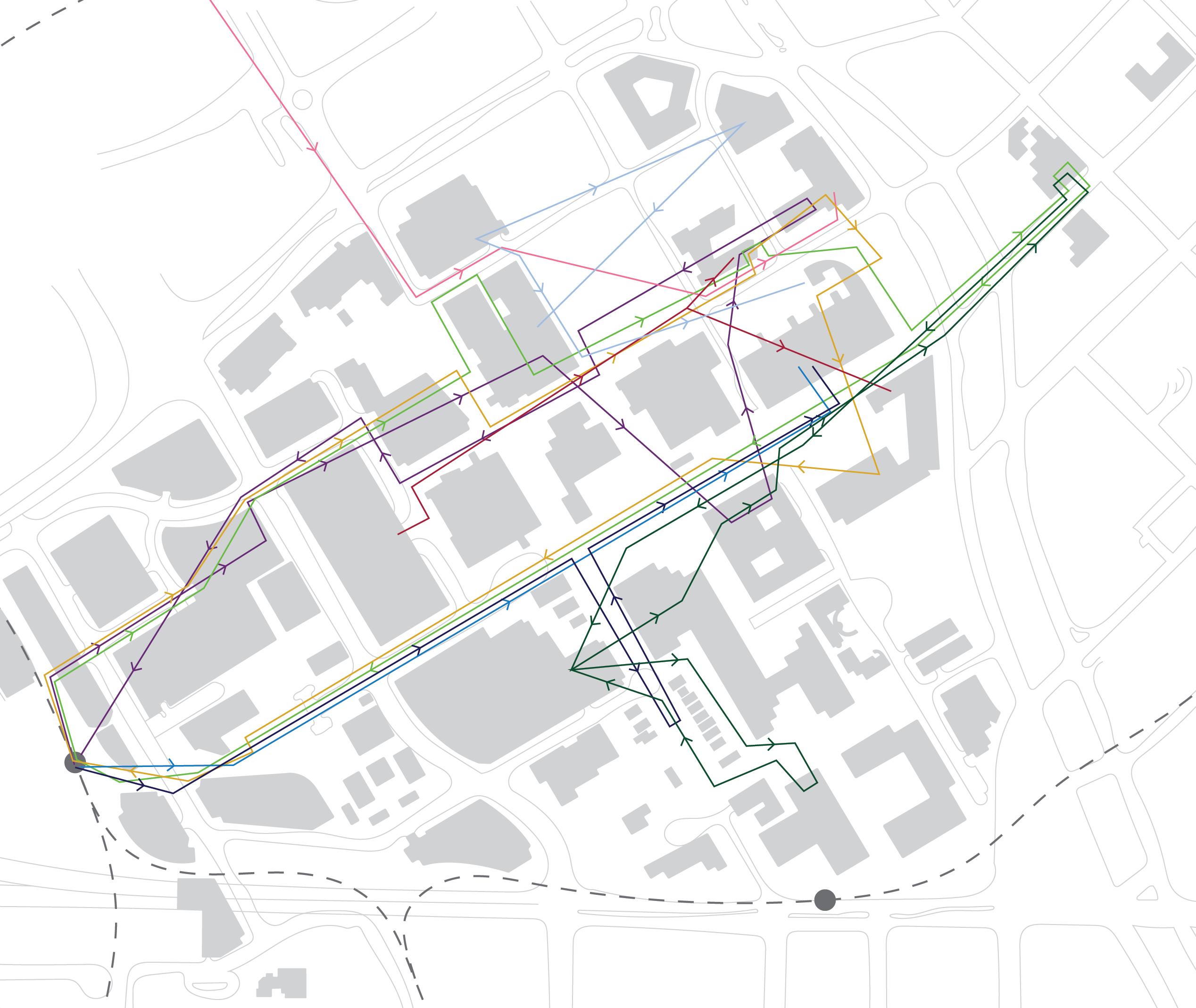
My First Time on Auraria Campus, I Could Find My Way Around Easily.
I Feel Comfortable Navigating Campus
What campus space do you think needs to be improved? Why? (hard to find, uninviting atmosphere, no space to study, etc)



“Lynx Central because I don’t even know where that is or what is there as resources to students.”
“Offices inside of the Tivoli, they’re incredibly hard to find”
“When looking for my classes the first time, I had some trouble identifying the buildings, but the maps helped. It was also impossible to find the class spaces in the Tivoli”
“The Art Building is probably the space that needs to be improved the most. Never have I felt like I was back in high school quite like that building”
“Its not a specific space I think make a clear sign for the buildings like the academic building I had no clue where it was until I looked it up online.”
“I feel like the buildings could be identified by their acronyms on schedules as well as their actual names, because I have trouble finding places. ”
What community space on campus do you think needs to be improved? Why? (hard to find, uninviting atmosphere, no space to study, etc)
“Tivoli or at least navigating to the Comcast center there. Maps are confusing and overwhelming”
“For me the most difficult part is to find buildings in general. But once I find it then it’s easy. Also sometimes it’s difficult to find bathrooms or classes. It’s was super difficult to find class building for Tivoli. ”
“Tivoli Quad. There’s needs to be more seating arrangements and ways to develop a sense of unity with all three campuses ”
“Seeing as I don’t know where any of the offices are for any kind of student life, that could probably be improved. This is my third year on campus and I have never found these offices.”
“The maps on campus, it can be hard to find some of the buildings”
“Parts of the Tivoli. It is so hard to navigate around there the first several times you go. There’s some sort of courtyard area that doesn’t make sense, and I didn’t even know half the offices in there even existed because they’re so hard to locate.”
I Know Where the Office of Student Life Is.
I Can Navigate to the Office of Student Life Easily and Without Much Assistance.
I Know Where the CU Denver Counseling Center Is.
I Can Navigate to the CU Denver Counseling Center Easily and Without Much Assistance. The Signs on Campus Help Me Navigate to New Locations Easily. The Building Names are Clearly Displayed and Easy to Find.
What do you think could improve students finding belonging on campus in their first semester?




What experiences have you had when accessing campus resources that should be improved?
“Maybe make better maps and name buildings the way it can be seen clearly from far away.”
“Clear signage directing students to certain buildings.”
“Possibly more signs in the buildings such as the Art building and the Tivoli? Or at least more accessible maps?”
“Guides on campus or more signs saying “this way is this building.” Maps can only do so much.”
“Clear signage directing students to certain buildings.”
“It was just hard to find classes and buildings in general.”
“A lot of the offices for campus resources are in the Tivoli, which is notoriously difficult to navigate.”
“A better way to navigate the campus or some type of somewhat detailed tour of the landscape of the campus with an easier way to understand where to go and where resources are accessible for students.”
“I felt like things should be easier to find. In general.”
“I’ve had a pretty good experience navigating resources once I have explored the campus. But needless to say, it’s very difficult to find anything if you just started going to CU Denver. There needs to be enhanced maps tied to each school/ building that tells you what offices are where and what things are available in each building. ”
“I had no idea where the counseling center was on campus. I never would have found it if one my RAs didn’t show me where it was. I think its important to know where it is because if there is a student who needs help, they should know directly where they can go. ”
For this exercise, I asked two volunteers to accompany me to Auraria Campus who have spent little to no time on the campus. Once on campus, I asked each volunteer, separately and on different days, to guide me to specific locations or offices located on campus.
Speer (Southbound) & Lawrence St.
at Auraria Station
CAMPUS MAPS & SIGNAGE COLFAX AT AURARIA TIVOLI STUDENT UNION
• Little to no maps in the middle of campus
• Hard to see sidewalks on map next to grass color
• Include sculptures on map as landmarks
• Very little signage to guide students to buildings
• Street Signs—not easy to notice; you’re not looking for street names when there’s only sidewalks
• Difficult to see building names
• Not clear that you should walk towards campus
• Welcome sign makes it seem like the campus is confused by their identity
• Only location to have any type of “welcome”
• Could have more obvious Auraria Campus signage that can be seen from the Light Rail and other vehicles
• Map and Directory are confusing

• Lynx Connect is labeled as room 479 when it is actually on the second floor of the annex
• Adequately labeled building
• Annex courtyard looks like an alley
• No indication in the annex courtyard that you have arrived at Lynx Connect
ARTS/WEST
• Assumes you already know where the offices, classrooms, and study spaces are
• No clear welcome to the building or directory
• Sign hierarchy could be updated
• Overhead signs do not have room numbers
• Could be more colorful/ less muted


CAMPUS MAPS & SIGNAGE COLFAX AT AURARIA TIVOLI STUDENT UNION ARTS/WEST/CENTRAL
• Street signs on pedestrian only areas are hard to see
• Building names are hard to find or do not have enough contrast between the building and text color
• Large Auraria Campus signs with institution names color makes them hard to spot
• Not very welcoming or appealing to interact with
• Does not look like a college campus
• Loud with the light rail, traffic, and construction
• Lots of signage in some areas, little signage in others
• Several different types of signage colors and styles
• Ramps are very steep and probably are challenging to navigate in a wheelchair
• Maps are not placed in visible areas near entrances
• Only found one location with wheelchair accessible entrances located at the bottom of a wheelchair inaccessible ramp
• Annex courtyard does not look like a “courtyard”
• Unwelcoming atmosphere
• Hard to tell where you are— everything looks the same
• Lighting in Central is darker and more yellow compared to other buildings
• Staircases in Central look like emergency exits; it is unclear if you can use them
• Central has two sets of entry doors which look like emergency doors that could set off the fire alarm
• Room numbers in all buildings could be larger
• Sign hierarchy needs to be updated

Shared buildings look similar/the same or are connected
Lack of campus maps in the middle of campus
Assumes a student knows where everything is
External building names are hard to find
WAY-FINDING
Some buildings have a dull atmosphere or have pests
Building interiors don’t have a clear or consistent welcome
No visual language to indicate to someone to go towards campus at entrances
No clear visual distinction between campus entrances and what is not campus from the road or Light Rail.
Lack of consistent signage across campus & buildings
Current campus welcome signs look like they belong to CU Denver’s not AHEC’s
No clear guidelines for campus signage from AHEC
WAY-FINDING
Little to no signage guiding students to buildings
Unclear where AHEC’s identity is present
Urban, commuter campus near Downtown Denver
3 higher education institutions on one campus
Split into “neighborhoods” and shared spaces
CAMPUS EXPERIENCE
First 6 weeks of first semester are critical in finding community and belonging
Being unable to find classrooms, resources, or community spaces makes finding belonging a challenge
More challenging for commuter students
Commuter students may spend less time on campus due to other commitments





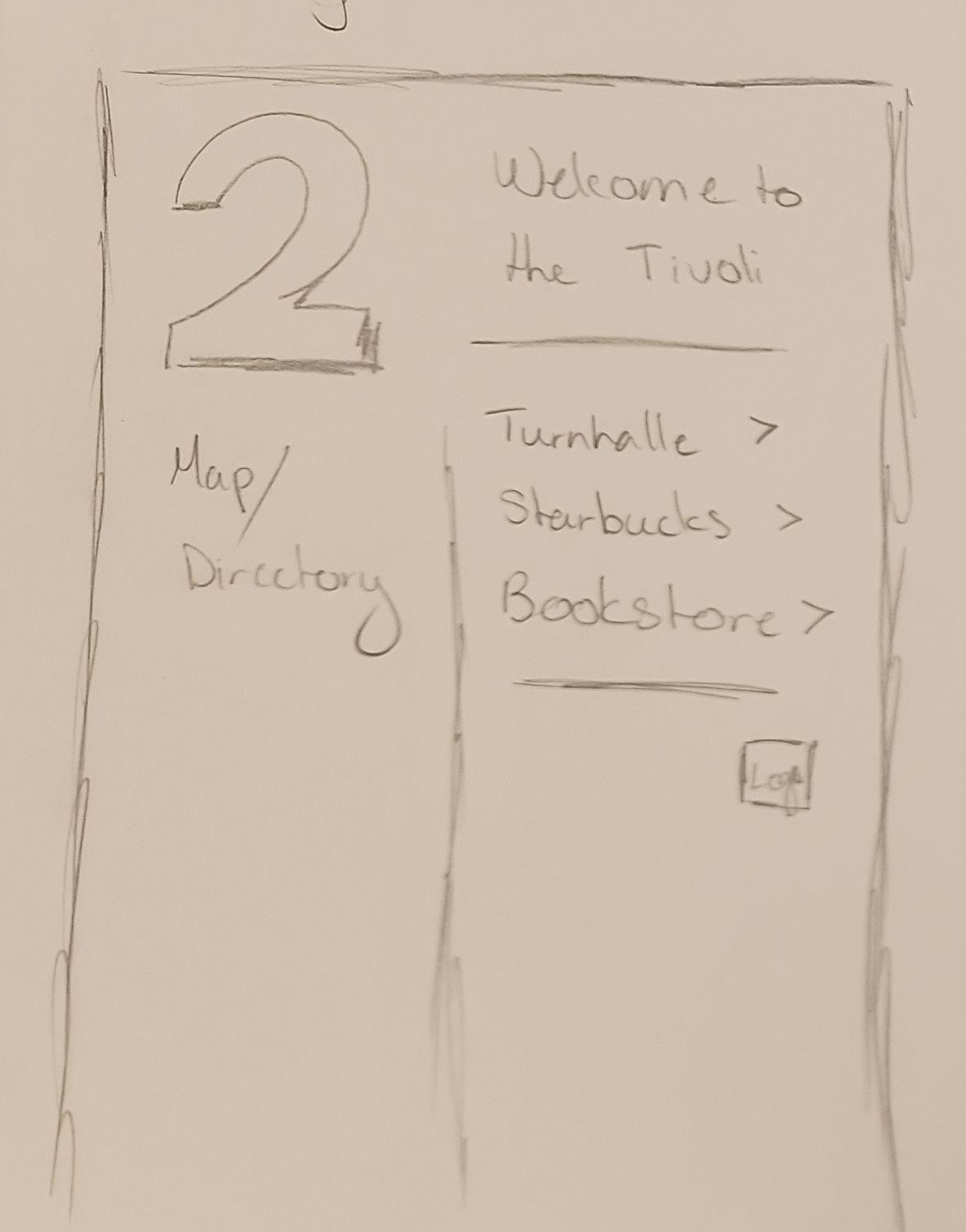
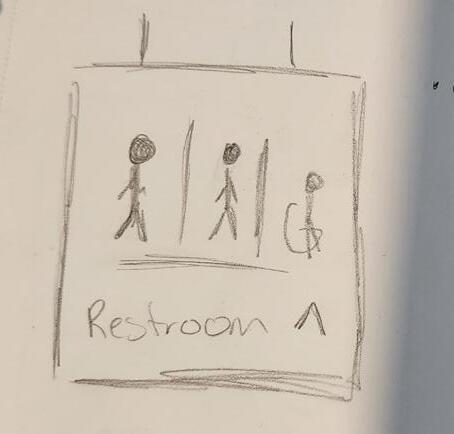




To begin brainstorming methods to improve the user experience of Auraria Campus, I first focused on the Auraria Higher Education Center’s (AHEC) identity as it is currently present on campus. As it stands, the individual education institutions on the campus have strong visual identities while AHEC’s is not as present.
My first step in learning more about AHEC’s identity was to read their brand style guide. This included information regarding their logo and brand colors. The shape of the current AHEC logo is a visual representation of the three institutions on campus–CCD, MSU, CU Denver–with AHEC being represented as the triangle uniting the entities in the middle.1 The AHEC brand utilizes a triangular shape as an allusion to traditional imagery surrounding higher education; the blue colors are presented as colors that evoke feelings of truth, honesty, and integrity.2
After reading more about AHEC’s brand, I decided to begin by updating their logo. I started by thinking about AHEC uniting the three institutions while also experimenting with the AHEC letters. However, after receiving feedback, I realized that the original logo was also meant to resemble the letter A in the negative space.


As a result, I went back to sketching and experimented with how I could break apart the letter A to communicate the same ideas as the original logo while creating a new logo that is inviting, resembled the letter A, and would help inform my process of creating user experience solutions on campus.
1 Brand Style Guide (Denver: Auraria Higher Education Center, 2017), 3.
2 Brand Style Guide (Denver: Auraria Higher Education Center, 2017), 3.

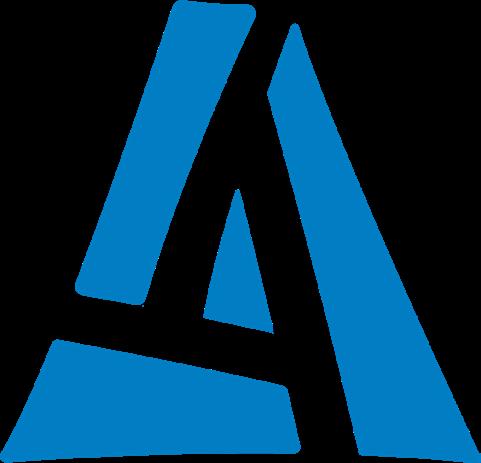


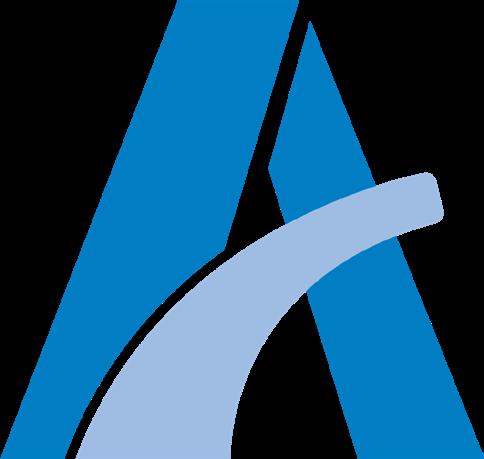


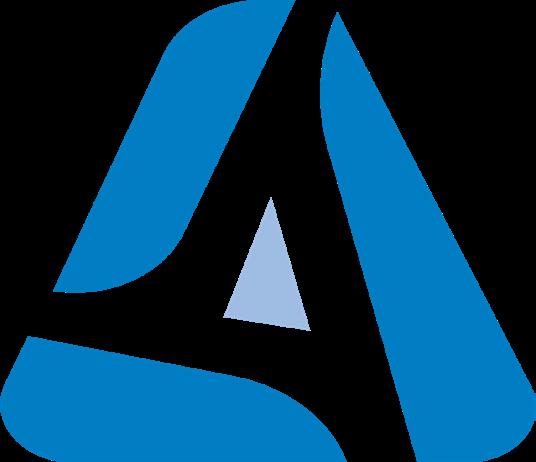


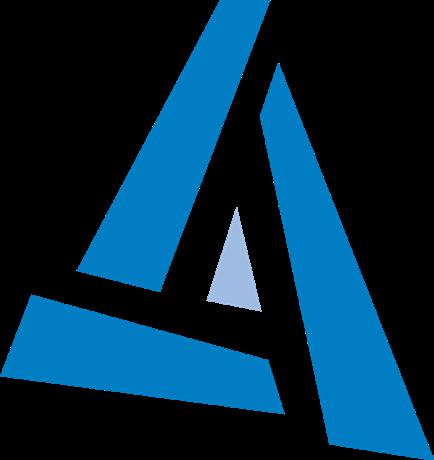






To see the completed deliverables, scan the QR code.

AHEC LOGO REDESIGN

MASTER LOGO

VARIATIONS
Blue
Monochrome
ALTERNATE LOGO
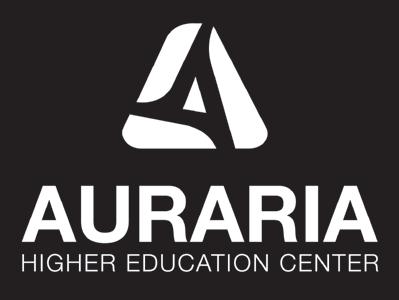
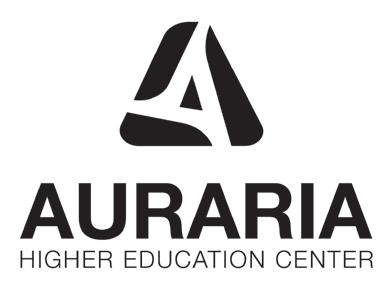
Inverted

This color palette is taken from the Auraria Campus Brand Style Guide.
HEX #007DC3
R0 G125 B195
C89 M43 Y0 K0
HEX #9FBDE3
R159 G189 B227
C36 M17 Y0 K0
HEX #000000
R0 G0 B0
C0 M0 Y0 K0
TYPOGRAPHY
Heading
Helvetica Neue Bold
ABCDEFGHIJKLMNOPQRSTUVWXYZ
abcdefghijklmnopqrstuvwxyz 123456789?!@#$%^&*()
Helvetica Neue Light
ABCDEFGHIJKLMNOPQRSTUVWXYZ
abcdefghijklmnopqrstuvwxyz 123456789?!@#$%^&*()
The gallery installation created for this exhibition will consist of a vinyl decal, printed images, and a wooden sign. Items available to take away will consist of a pamphlet containing a redesigned Auraria Campus map.
The space for the installation will be shared with another student who will utilize the right half of an eight-foot wall. We will share a 22-inch shelf in the center of the wall located at standard counter-top height. The shelf will hold both of the process books for our individual projects.
The vinyl decal will be from Mad Graphics 303, which is approved by RedLine Contemporary Art Center. In addition to the decal on the wall, the vinyl decals will also consist of footprints located on the floor in front of the wall. These footprints will serve as matter out of place to guide gallery viewers to the installation. The remaining hanging wall elements will be attached to the wall with either nails or push-pins.



Hayley Black graduated in May 2023 from the University of Colorado Denver’s College of Arts and Media program with her Bachelor’s of Fine Arts in Digital Design, in addition to minors in Leadership Studies and Art History. During her time at CU Denver, Hayley has mentored first-year CAM students as a Peer Advocate Leader. Over the summer, she has worked as a Teaching Assistant and Lynx Leader
Hayley has a passion for typography, motion graphics, and photography. After studying abroad in May 2022, she has been increasingly interested in the way design can help create solutions to problems that are more human-centered. After graduating (and after Lynx Camp), Hayley is interested in continuing to pursue motion graphics, brand design, and user experience design in her career.
When she is not working, you can find Hayley knitting, crocheting, or petting her two cats.

Michelle Carpenter
Travis Vermilye
Brian DeLevie
Maria Buszek
Christy Heaton
Angie Vandijk
Emilie Waggoner
Kelsi Miles
Jeppe Pendrup
Mama Kling
Erin
